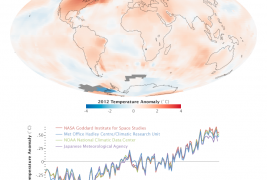Special to Ecology Florida News
Did you miss it? Early last month, atmospheric carbon dioxide topped 400 parts per million (PPM). With some notable exceptions, major news sources gave it light coverage. Admittedly, its significance is largely symbolic – although there is a correlation between increasing atmospheric carbon and more intense weather phenomena, including the tornadoes that devastated Moore, Oklahoma, and other parts of the Lower Midwest.
Like other events, symbolic and otherwise, passing the 400 PPM threshold may spin for a time in the media blender of popular culture – slathered in rhetoric and gummed up by doubt. Politicians and the media may frame the 400 PPM moment using old slogans and tired ideological contrasts, while trolls drag down critical thought to name calling and dislike of President Obama. Lost in the blender’s whirl is the relationship of 400 PPM to questions of sustaining life on the planet – less important than the tired tirades and traditional tropes of left and right.
So, as a public service, we’ll inform readers that history was indeed made on May 9, 2013, when atmospheric CO2 was first recorded above 400 PPM. The date will probably not be remembered or find its way into history books. Nonetheless, it is an important moment in human and planetary history.
What were you doing on May 9? Were you using any carbon-based technology? Do you have a refrigerator, drive a car, eat oranges from California in the Florida spring? This is not a scold article, only a pause piece. When you are at the grocery, does the bagger ask, “Is plastic okay?” This is just a pause to contextualize May 9.
400 PPM makes May 9 a turning point. Its meaning is derived from what has come before and what may come to pass in the future. Going forward, if the date is remembered at all, it will be associated with climate change, and whether or not we, as a global community, take any sort of meaningful action to avert the stunning consequences of a rapidly warming planet.
400 PPM is the highest concentration of CO2 ever recorded, and probably the highest in the history of humankind. It is notable, too, because it marks the current point on an ever-ascending graph – the Keeling Curve.
Folks reading this article may already be aware of CO2 being a major greenhouse gas, and that 400 PPM of CO2 is probably not sustainable. We are reminded that since atmospheric carbon began being measured at the famous Mauna Loa site by the equally famous Charles Keeling (he of the “Keeling Curve”), CO2 PPMs have never declined.
Keeling, an oceanographer by trade, began taking CO2 readings in 1958. The readings for that first year were 317.45 PPM. They have increased every year since – passing the mythic 350 PPM in 1987, 375 PPM in 2002, and 400 in early May, 2013. The majority of scientists who research our planet’s systems agree that 350 PPM is the highest sustainable level for atmospheric carbon. We are well past 350 now, and there are no signs we are slowing down. In fact, we are speeding up.
Check with the leaders in Beijing and New Delhi on slowing down the carbon loading. While you are at it, check with those American Exceptionalists who deny climate change from congressional seats padded with oil company contributions and insulated from cultural reality and political challenge by gerrymandered districts and the cunning suppression of majority will.
So, with the support of gerrymandered office holders in America, developing Asian industrial powers, and the semi-conscious complicity of the educated classes, once we passed 350 PPM, carbon loading accelerated. It was only a matter of time before we passed 400.
Folks who read publications like this saw it coming. Climate scientists saw it coming. Environmental reporters for major media sources saw it coming. Plenty of children in elementary schools saw it coming. It was only a matter of time, and many of us have seen it coming for years. How old will those school children be when we pass 425, 450, 475? Will they see those CO2 concentrations coming as we saw 400?
Bill McKibben saw accelerating CO2 concentrations coming in the 1980s, and issued early warnings in his famous book of 1989, The End of Nature. He has been warning us ever since – even forming an organization whose name (350) affirms the sustainable CO2 ideal. McKibben is a good writer, and an excellent motivator. One of his best short pieces on this topic was published in Rolling Stone (July 19, 2012), “Global Warming’s Terrifying New Math.” How much of a leader he is remains to be seen.
Colorado’s State Climatologist, Nolan Doesken, saw it coming, too. He just did not expect its consequences to hit home so soon. For an outstanding report on the cultural dimensions of climate change, and Doesken’s sense of foreboding, see This American Life (May 18, 2013), “495: Hot In My Backyard.”
Friends, it is hot in everyone’s backyard – and if the serious scientists are right, it won’t be getting cooler in our lifetime. Really? Yes, according to the National Aeronautics and Space Administration and the National Oceanic and Atmospheric Administration, we can expect continual warming of the planet (and our own backyards) for the foreseeable future.
Aside from occasional cool spells, the steady march of higher temperatures will continue through the lifetime of everyone living on the planet, and the lifetime of their children – and their children’s children. Last year was the hottest year on record in the USA, and recent years over the past decade have been among the hottest ever recorded. (http://www.huffingtonpost.com/2013/01/08/2012-hottest-year-on-record_n_2433210.html)
The BBC had a story about the 400 event, focusing on James Butler, who works at Mauna Loa. Butler saw it coming, too. For him it was news that was no news.
Finally, as the “no-news” 400 PPM story was receding into insignificance, The Tampa Bay Times published an article by a USF faculty member, Edward Renner. His “How to Save the Planet,” is as ambitious as it is hopeful. Any organization committed to sustainability, and just keeping human culture going for another century ought to endorse his suggestions. It is worth reading. Yes, and be sure to send copies to your colleagues in Beijing and New Delhi – and especially any Exceptionalists you know on Capitol Hill.
The 400 PPM story is indeed no news now. It was old news when it was announced. We saw it coming, and watched it pass with little notice and seemingly less concern. Bill McKibben is just as committed as ever, still writing, still warning, still motivating. Senator Inhofe is no more convinced now than he was before the Cat. 5 tornado swept out of the climate-changed storms of the Lower Midwest and devastated parts of his state. Nolan Doesken is probably even more concerned as another fire season draws neigh in Colorado. The workers in the oil fields of South Dakota and tar sands of Alberta are still just happy to have jobs. And agents of old industry and blind commerce continue to promote the Keystone X-L Pipeline with neither interest nor concern for all the heat it generates.
So, as the 400 PPM moment fades from consciousness, what we ought to remember is not so much the significance of this event – as expected as it was, after all. Instead, our takeaway might be, that it will be higher next year, as it has been ever since records have been kept; and so will the temperature in our own backyards, and those of our children, and their children, too.
Reference and Related Sources
NPR (May 10)
‘Dangerous Territory’: Carbon Dioxide Levels Reach Milestone
BBC
http://www.bbc.co.uk/news/science-environment-22486153
Christian Science Monitor
http://www.csmonitor.com/Environment/Latest-News-Wires/2013/0510/Atmospheric-carbon-dioxide-levels-reach-milestone?utm_source=feedburner&utm_medium=feed&utm_campaign=Feed%3A+feeds%2Fenvironment+%28Christian+Science+Monitor+|+Environment%29
“Global Climate Change Indicators” National Oceanic and Atmospheric Administration, National Climatic Data Center
Global Warming (NASA)
http://earthobservatory.nasa.gov/Features/GlobalWarming/
NASA “Earth Observatory”
http://earthobservatory.nasa.gov/IOTD/view.php?id=80167
[note color=”#e6fce1″]Dell deChant is a Master Instructor and Associate Chair of the Department of Religious Studies at the University of South Florida. He is the author of three books, over 30 articles in professional publications, and chapters in ten books. His specialization is religion and contemporary cultures. His recent research focuses on the contemporary ecological crisis as it manifests in American popular culture and religion.
deChant serves on the Environmental Committee of the City of New Port Richey, the board of directors of Ecology Florida, and the steering committee for Friendship Farms & Fare.[/note]


Leave a Reply